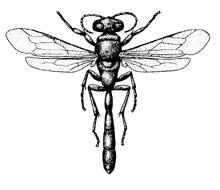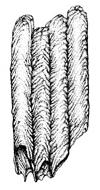
Mud Stingers



Mud Stingers may become a nuisance when they construct nests of mud near the Holt or on walls and under roof overhangs around homes and other structures of Ishmar. They are considered just pests since nests are not defended and stings are rare. In spite of their formidable appearance, these solitary Mud Stingers are not aggressive. Elves and humans usually let them be. They are beneficial by sometimes killing dangerous spiders.
 Appearance: Adults Mud Stingers grow to about 1/2 to 3/4 inch long, metallic blue to blackish, with blue wings. They build finger-like nests of mud attached to flat surfaces under roof overhangs, under eaves, etc. The nest is a series of parallel mud tubes of varying length, like a pipe organ with several or many tubes in a row.
Appearance: Adults Mud Stingers grow to about 1/2 to 3/4 inch long, metallic blue to blackish, with blue wings. They build finger-like nests of mud attached to flat surfaces under roof overhangs, under eaves, etc. The nest is a series of parallel mud tubes of varying length, like a pipe organ with several or many tubes in a row.
Life-Cycle: Mud Stingers are often seen at the edge of mud puddles collecting mud to construct their nests. Mud Stinger nests are partitioned off with mud and each cell is provisioned with several paralyzed spiders and implanted with an egg. Female Mud Stingers paralyze spiders, pack them into the cell with their head until full, lay one egg and seal the cell. After egg hatch, larvae feed on captured spiders with larvae maturing in about three weeks. They then spin a cocoon and spend the winter in the nest ... to hatch next spring. Males guard the nest while the female forages. Mud cells may be constructed in deserted nests of other Mud Stingers.
 Solitary Mud Stingers are very different than the social wasps. There is no worker caste and the queens must care for their own young. Mud Stinger wasp queens use their sting to paralyze their prey (spiders) rather than to defend their nests. These wasps are non-aggressive and rarely sting unless touched or caught in clothing.
Solitary Mud Stingers are very different than the social wasps. There is no worker caste and the queens must care for their own young. Mud Stinger wasp queens use their sting to paralyze their prey (spiders) rather than to defend their nests. These wasps are non-aggressive and rarely sting unless touched or caught in clothing.
Mud Stingers hatch in the spring and usually die at the first hard frost. Females are the hunters ... males defend and build the nests.
Venom: The venom of Mud Stinger used to paralyze spiders in not usually fatal. The sting causes mild pain, swelling and itching.